March 11, 2011. A magnitude 9.0 earthquake struck off-shore and birthed a terrible black wave that hit the coastal areas. Iwate Prefecture, Miyagi Prefecture, Fukushima Prefecture, and the rest of the northeastern coast of Japan are still hard at work rebuilding the stricken coastal areas. As part of Iwate’s reconstruction plan, there are a number of forward-looking projects that serve to develop and grow the Sanriku coast of Iwate so that its communities may continue into the future. Part of that is the International Linear Collider and other science-based initiatives.
Japan is a seismically active country, and earthquakes are just a fact of life here. While a natural disaster on the scale of the 2011 earthquake is said to be something that happens once a millennia, it’s a good idea to know what happened to be prepared in the future. We can’t forget that day, and the tragedy it brought. But we can teach others how to prepare.
As an aside, I do want to be clear that the granite bedrock in the Kitakami mountains site is stable enough that even a 9.0 earthquake does little effect. A pre-existing scientific facility in a tunnel in the mountains (the Esashi Earth Tides Station) reported absolutely no damage done from the quake, and the ILC will be built to the same such specifications.
The day of the earthquake and tsunami
March 11, 2011. 2:46 pm. A magnitude 9.0 earthquake strikes off the coast of Miyagi Prefecture, producing a tsunami that hits the northeastern coast of Japan.
The major characteristic of this disaster was that it was three-pronged: the earthquake, the tsunami, and the accident it caused at the Fukushima Daiichi Nuclear Power Plant.
Iwate’s Reconstruction
Iwate established its reconstruction plan in August 2011 for an eight year period until 2018. The plan set up a 3-year setup phase, a 3-year focused reconstruction phase, and a 2-year connection phase for further development. Currently, Iwate is at peak operations – they have the most projects going on at one time.
Even though the reconstruction has been progressing at a steady pace, there are still over 22,000 people living in the temporary housing units set up after the disaster or in other accommodations. We still have a lot of work to do for our recovery. Right now the prefecture and municipal governments are busy with constructing 5,771 units of permanent public housing for the survivors, with around 90% to be finished within the 2016 fiscal year.
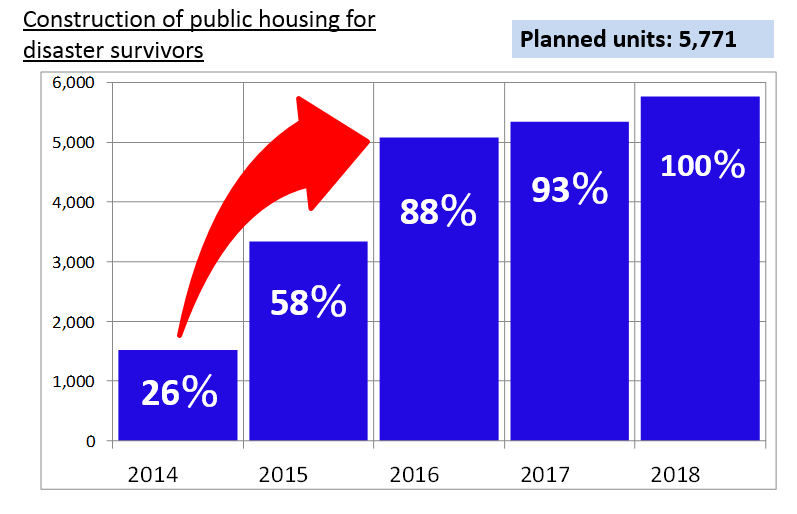
As we try to move the survivors to permanent housing as quickly as possible, we must also think about how to best support individual survivors. How do we ease their physical and mental burdens arising from a long period in temporary housing? How do we foster a sense of community at the new housing complexes? How do we calm their fears of the future? Mental care centers have been set up to send staff throughout the region, and we must continue to think about these issues.
Achievements of the reconstruction
In the five years post-disaster, Iwate has accomplished a lot:
・All of the disaster debris (over 61 million tons) was completely cleaned up and cleared out by March 2014
・All lines of the Sanriku Railway, a railroad that traverses the coast of Iwate were back up and running by April 2014. The Sanriku Railway is also taking over ownership of the JR train line between Miyako and Kamaishi (central to southern coast), and once the line is rebuilt there will be a network of trains that will take you from Kuji City in north Iwate to Ofunato City in the south. (close to 160 km!)
・Damaged fish markets and most of the schools have reopened; hospitals and areas of commerce are all being rebuilt.
・In 2014, visits to major tourist destinations reached 104% of levels seen before the disaster.
・As of December 2015, 48% of permanent public housing (2,748 units) have been completed, with the rest to be finished by 2018.
・A new network of “reconstruction roads” is in the process of being built, including the Sanriku Coastal Road, a huge stretch of highway that will connect the northern coast to the southern coast. Some of the sections are now in-service.
One of the biggest feats of the reconstruction has to be the Bridge of Hope in Rikuzentakata City (southern coast). This massive belt conveyor was constructed to transport soil from the nearby mountains to the city center, where they are raising the ground level for new construction. It would have taken almost 10 years for large trucks to carry this amount of dirt, but with the Bridge of Hope, it was completed in around a year and a half. Its purpose was completed in September 2015, and preparations have started to dismantle it.
・Many more projects are happening at this moment. You can learn more by checking out the “IWATE: Moving Towards Reconstruction” pamphlet created by our Bureau of Reconstruction.
However, even though fish catch levels have recovered to about 80% of the levels seen before the disaster, the recovery of the fishing industry has been lagging. Fishing has long been the staple business of the coast of Iwate, but it’s tough to find young, able-bodied people available to work. Securing workers and financial capital for the reconstruction is still of the utmost importance. The area was struggling even before the disaster, so much work is left in order to improve its economy.
New developments for Iwate, and a new Sanriku Coast
The driving force behind our reconstruction is the fundamental strength of the people of Iwate, as well as the bonds we have forged with the rest of Japan and the world. Reconstruction means we’re not going to let our homeland be erased. We need the reconstruction to be an impetus in developing the local region – to make a Sanriku coast and Iwate Prefecture that are even stronger than before.
This is the aim of the Sanriku Creation Project, a collection of initiatives that will maximize the potential of Sanriku’s unique environment. The International Linear Collider and other international research exchanges fall under this project, but there are also park projects (like the Sanriku Geopark and Reconstruction Memorial Parks), eco-town projects using renewable energy, and development of an Iwate-sourced cobalt alloy called “Cobalion ©” and other high-tech materials.
That returns us to the ILC. The search for the Higgs boson and other mysterious particles will have numerous benefits for particle physics and mankind, but it will also be a boon to all of Tohoku that is rebuilding from the disaster. If the ILC is built here, the collider will stretch from Oshu and Ichinoseki inland to Kesennuma on the coast of Miyagi Prefecture. Parts will be shipped to harbors like the one in Kesennuma, and factories may be built in the surrounding areas. Existing companies are already attending events to learn how to get involved with accelerator-based industry. Current estimates have the ILC increasing employment throughout Japan by 250,000 during its thirty years of planned operations.
If the ILC is indeed hosted in the area, it will be a beacon of hope to the survivors on the coast, and a way for Iwate to give back to the world after it supported us during the disaster.

The coast of Iwate
If you’d like to learn more about Iwate’s reconstruction and stay abreast of further updates, visit our English page:
News from Iwate’s Reconstruction
Pamphlet PDF: (2014) IWATE: Moving towards reconstruction
Japanese
復興とILC3.11から5年が経ちます。東北では、ILCの実現を願っています。それは、東北の復興にも資するものです。
和山アマンダ
2011年3月11日。宮城県沖にマグニチュード9.0の地震が発生し、街を襲う大きな津波を引き起こしました。岩手県、宮城県、福島県、そして東日本のすべての被災地が復興に向けてまだ懸命に努力しています。岩手県の復興計画の一つとして、いくつか岩手県三陸地域の持続可能な将来に向けたプロジェクトがあります。国際リニアコライダーなどの研究プロジェクトもその一部です。
東日本大震災津波は1000年に一度の規模と言われる大災害ですが、将来に備え震災をよく理解することは大切です。私たちはあの日を、あの悲劇を忘れません。そして、他の方々に震災の教訓を伝えていきます。
余談ですが、私は、ILC建設候補地である北上山地の花崗岩体が、マグニチュード9.0の地震でもほとんど影響がなく、非常に安定していることを明言したいです。山地のトンネルに既にある研究施設(江刺地球潮汐観測施設)は被害の報告が一切ありませんでした。ILCも同じ花崗岩体に建設されます。
地震・津波が発生したあの日
2011年3月11日。午後2時46分。宮城県沖にマグニチュード9.0の地震が発生し、東日本を津波が襲いました。
【上記の図 岩手県における被害状況 英語版】
東日本大震災津波の特徴は、地震、津波、原発事故の複合災害であることです。
岩手の復興
2011年8月、岩手県は2018年度までの8年間の復興計画を策定しました。計画では、3年間の基盤復興期間、3年間の本格復興期間、そして2年間のさらなる発展への連結期間と位置付けました。現在、岩手県の復興事業はピークを迎えています。
復興は道路・港湾など着実に進んでいますが、未だ2万2千人余りの方々が応急仮設住宅等での不自由な生活を余儀なくされています。復興まではまだまだ活動が必要です。現在、県及び市町村は、災害公営住宅5,771戸の整備を進めており、2016年度中に約9割の災害公営住宅を完成させる予定です。
被災者の方々に、一日も早く恒久的な住宅に移っていただくことに加え、私たちは被災者一人一人の支援のあり方を考えなければいけません。応急仮設住宅等での生活の長期化による心と体の健康の問題、移転先の団地等での新たなコミュニティの形成、将来の生活への不安などにどう対応していくのか。心のケアセンタ―が地域に設置されていますが、被災者一人一人が抱える課題に寄り添い、継続的な支援をどう進めていくか考え続けることが必要です。
復興の成果
東日本大震災が発生してから5年間で、岩手は様々なことに取り組んできました。
・2014年3月、約584万トンの災害廃棄物を全量撤去。
・2014年4月、岩手沿岸をまたがる三陸鉄道の全線運行再開。
・被災した学校、魚市場、病院、商店街などが復旧中。
・2014年度の主要観光地の入込数は、震災前と比較して104.8%の水準まで回復。
・2015年12月時点で、災害公営住宅の48%(2,748戸)が完成、残りは2018年度までに完成予定。
・三陸沿岸道路を含め、新しいネットワークとなる復興道路も整備されており、沿岸の北部から南部まで結ばれます。
復興の大きな取組の一つは、陸前高田市の「希望の架け橋」です。この巨大なベルトコンベアーは、近くの山から市街地に土砂を運搬するために建設され、新たな建設地の盛土を形成しました。大きなトラックで運搬した場合約10年かかる作業を、ベルトコンベヤーの導入により約1年半で完了しました。2015年9月、その役目を終え、撤去が始まりました。
・これらの他に、様々な取組が進んでいます。詳しくは、岩手県復興局が発行した「岩手 復興の歩み」をご覧ください。
一方で、水産業の水揚げ量は震災前の8割まで回復しましたが、復興は道半ばです。漁業は昔から岩手県沿岸の主要産業でしたが、担い手の確保や育成が大きな課題です。
復興に向けて、人材と財源の確保が最も重要です。震災前でも沿岸部は苦労しており、地域経済の発展が課題です。
ふるさと振興と新たな三陸海岸
私たちの復興の原動力は、岩手県民全体の「地元の底力」と、全国、そして世界に広がる「様々なつながり」です。復興は「ふるさとを消滅させない」という意味で、ふるさと振興と相通じるものです。岩手県の復興は、そのまま岩手県の地域振興、ふるさと振興になります。
これも、三陸地域の特性を最大限に生かす「三陸創造プロジェクト」の目的です。このプロジェクトの中に、ILCを含む国際研究交流拠点形成プロジェクトが入っているほか、三陸ジオパークや津波復興祈念公園の整備や、再生可能エネルギーを使うエコタウンの形成、 「いわて発」高付加価値コバルト合金(COBARION)などの開発の支援があります。
ILCでは、ヒッグス粒子などの他の新粒子の探索、基礎物理学及び人類へ多くのメリットをもたらすほか、震災からの復興を目指す東北の力にもなります。ILCがこの地域で建設されれば、加速器が内陸の奥州市・一関市から、宮城県沿岸の気仙沼市まで設置されます。様々な部品が、気仙沼港などから輸送され、工場が周辺に建設されるかもしれません。企業は、加速器関連産業に参入するため、既にセミナーなどに参加し準備を進めています。また、現在の推計では、ILCの建設から運用までの30年間で、約25万人分の雇用の創出が見込まれています。
ILCは日本が世界、人類に対して大きく貢献できます。ILCが東北で実現すれば、東北に住む我々にとっても希望の光となり、岩手にとって世界から支援を受けた恩返しの機会ともなります。
岩手県の復興について詳しく知りたい方:
英語版のホームページをご覧ください。
News from Iwate’s Reconstruction(英語版の復興だより)
Pamphlet PDF: (2014) IWATE: Moving towards reconstruction (「復興の歩み(2014年)」の英語版)
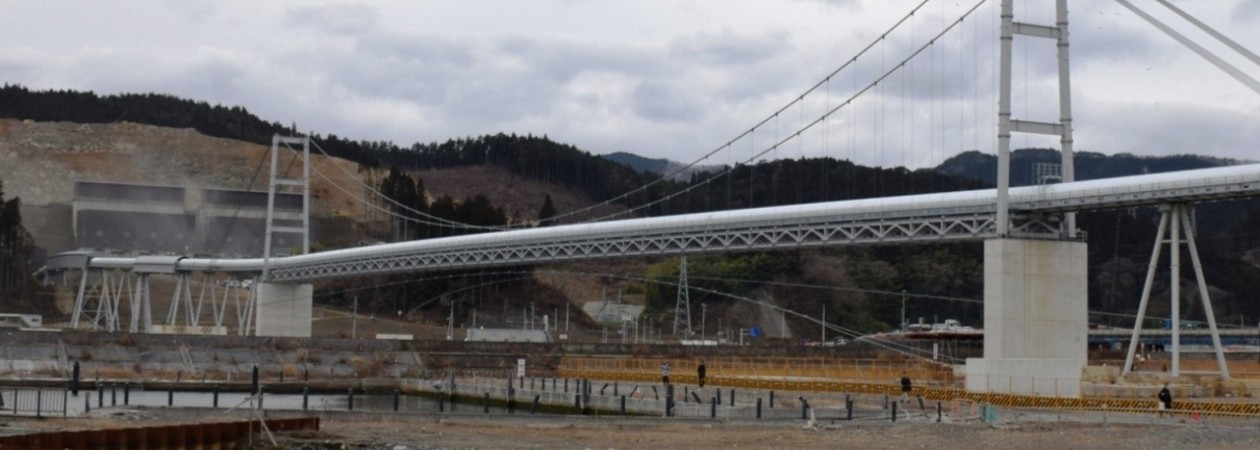
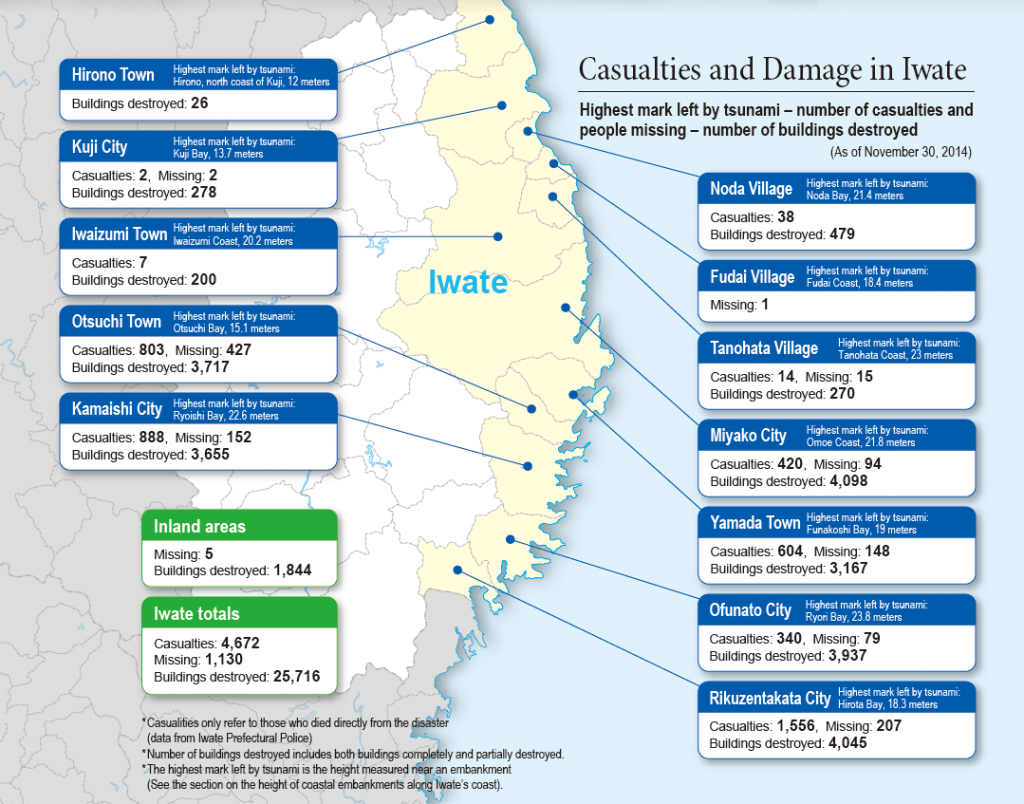
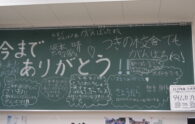
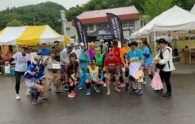
-195x124.jpg)